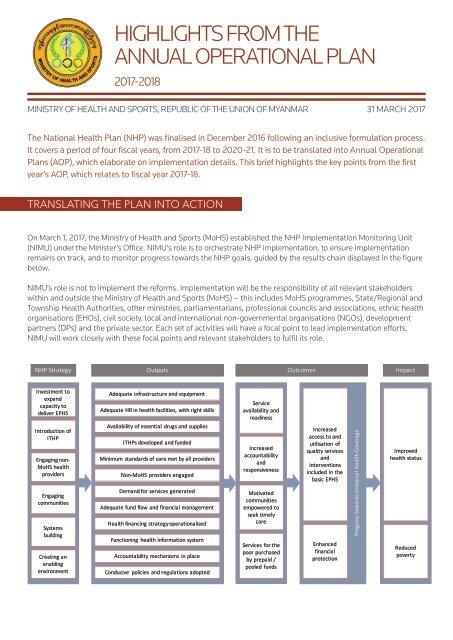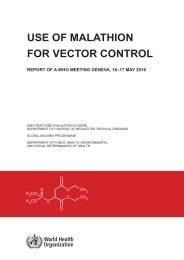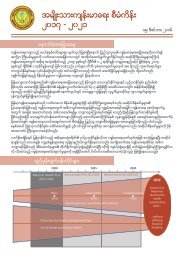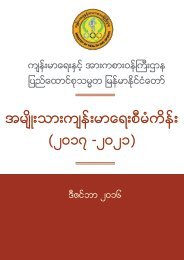NHP (2017-2021) Highlight_Annual Operational Plan_ENG
You also want an ePaper? Increase the reach of your titles
YUMPU automatically turns print PDFs into web optimized ePapers that Google loves.
HIGHLIGHTS FROM THE<br />
ANNUAL OPERATIONAL PLAN<br />
<strong>2017</strong>-2018<br />
MINISTRY OF HEALTH AND SPORTS, REPUBLIC OF THE UNION OF MYANMAR 31 MARCH <strong>2017</strong><br />
The National Health <strong>Plan</strong> (<strong>NHP</strong>) was finalised in December 2016 following an inclusive formulation process.<br />
It covers a period of four fiscal years, from <strong>2017</strong>-18 to 2020-21. It is to be translated into <strong>Annual</strong> <strong>Operational</strong><br />
<strong>Plan</strong>s (AOP), which elaborate on implementation details. This brief highlights the key points from the first<br />
year’s AOP, which relates to fiscal year <strong>2017</strong>-18.<br />
TRANSLATING THE PLAN INTO ACTION<br />
On March 1, <strong>2017</strong>, the Ministry of Health and Sports (MoHS) established the <strong>NHP</strong> Implementation Monitoring Unit<br />
(NIMU) under the Minister’s Office. NIMU’s role is to orchestrate <strong>NHP</strong> implementation, to ensure implementation<br />
remains on track, and to monitor progress towards the <strong>NHP</strong> goals, guided by the results chain displayed in the figure<br />
below.<br />
NIMU’s role is not to implement the reforms. Implementation will be the responsibility of all relevant stakeholders<br />
within and outside the Ministry of Health and Sports (MoHS) – this includes MoHS programmes, State/Regional and<br />
Township Health Authorities, other ministries, parliamentarians, professional councils and associations, ethnic health<br />
organisations (EHOs), civil society, local and international non-governmental organisations (NGOs), development<br />
partners (DPs) and the private sector. Each set of activities will have a focal point to lead implementation efforts.<br />
NIMU will work closely with these focal points and relevant stakeholders to fulfil its role.<br />
<strong>NHP</strong> Strategy Outputs Outcomes Impact<br />
Investment to<br />
expand<br />
capacity to<br />
deliver EPHS<br />
Introduction of<br />
ITHP<br />
Engaging non-<br />
MoHS health<br />
providers<br />
Engaging<br />
communities<br />
Systems<br />
building<br />
Creating an<br />
enabling<br />
environment<br />
Adequate infrastructure and equipment<br />
Adequate HR in health facilities, with right skills<br />
Availability of essential drugs and supplies<br />
ITHPs developed and funded<br />
Minimum standards of care met by all providers<br />
Non-MoHS providers engaged<br />
Demand for services generated<br />
Adequate fund flow and financial management<br />
Health financing strategy operationalised<br />
Functioning health information system<br />
Accountability mechanisms in place<br />
Conducive policies and regulations adopted<br />
Service<br />
availability and<br />
readiness<br />
Increased<br />
accountability<br />
and<br />
responsiveness<br />
Motivated<br />
communities<br />
empowered to<br />
seek timely<br />
care<br />
Services for the<br />
poor purchased<br />
by prepaid /<br />
pooled funds<br />
Increased<br />
access to and<br />
utilisation of<br />
quality services<br />
and<br />
interventions<br />
included in the<br />
basic EPHS<br />
Enhanced<br />
financial<br />
protection<br />
Progress towards Universal Health Coverage<br />
Improved<br />
health status<br />
Reduced<br />
poverty
FOCUS OF THE FIRST YEAR’S ANNUAL OPERATIONAL PLAN<br />
The first year’s AOP adheres to the <strong>NHP</strong> strategies outlined in the results chain diagram. All activities included in the<br />
AOP will contribute to the <strong>NHP</strong> outputs, with a focus on the following:<br />
• Finalisation of the contents of the Basic Essential Package of Health Services (EPHS)<br />
• Initiation of the bottom-up inclusive planning process<br />
• Investment in the expansion of Townships’ capacity to deliver the Basic EPHS by improving service availability<br />
and readiness in the first 70 Townships<br />
• Strengthening of the health system to support effective delivery of the Basic EPHS<br />
• Development of an enabling environment<br />
• Monitoring and evaluation of the <strong>NHP</strong><br />
FINALISATION OF THE CONTENTS OF THE BASIC EPHS<br />
The first priority is to agree on the list of services and interventions that are included in the Basic EPHS. The main<br />
goal of the <strong>NHP</strong> <strong>2017</strong>-<strong>2021</strong> is to extend access to the Basic EPHS to the entire population by 2020 while increasing<br />
financial protection. The Basic EPHS is therefore at the core of the <strong>NHP</strong>. The contents of the basic EPHS will, for<br />
example, guide the development of job descriptions for the different cadres of health workers at Township level and<br />
below, starting with village-based health workers; it will help prioritise pre-service and in-service training, as well<br />
as the development of standards of care that can be adopted by all health care providers, whether managed by the<br />
government, EHOs, NGOs or private GPs.<br />
INITIATION OF THE BOTTOM-UP INCLUSIVE PLANNING PROCESS<br />
There is currently no single accepted model for Township health planning in the country. Getting all stakeholders<br />
(including MoHS, DPs, EHOs, private sector, civil society, etc.) to agree on a ‘national’ approach for the formulation of<br />
Inclusive Township Health <strong>Plan</strong>s (ITHPs) is therefore urgent. The Township-level planning exercise will be based on<br />
a thorough assessment of existing service coverage, considering all types of providers and including village-based<br />
health workers. This assessment will also need to follow a common methodology, which needs to be developed<br />
alongside the ITHP template and guidelines.<br />
In order to get all stakeholders on board, both the ‘national’ approach for the preparation of the ITHP and the<br />
‘national’ approach for the assessment of service coverage need to be developed in an inclusive manner. That will<br />
take some time. The goal is to have both finalised by June <strong>2017</strong>. The different stakeholders will then need to be<br />
trained so that they can start planning for fiscal year 2018-19 using the new template and guidelines.<br />
Township Health Working Groups will be established in each Township. These will be composed of representatives<br />
from all relevant stakeholders, including the TMO (as chair), EHOs, CSOs, NGOs, private sector, etc. These Township<br />
Health Working Groups will be in charge of:<br />
• Communication with NIMU<br />
• ITHP formulation<br />
• ITHP monitoring and monitoring of the <strong>NHP</strong> at the local level<br />
States and Regions will have their own Inclusive Health <strong>Plan</strong>s. They will play an important role in supporting and<br />
overseeing the planning and budgeting process, as well as the implementation of the ITHPs.<br />
The ITHP will outline how the different stakeholders will jointly strengthen the health system and expand service<br />
coverage within their Township, keeping the <strong>NHP</strong> goals in mind. <strong>Plan</strong>ning and budgeting cycles will be synchronised
in Year 1 to guarantee that ITHPs are adequately funded.<br />
In the absence of ITHPs for fiscal year <strong>2017</strong>-18, investments to expand coverage in Year 1 cannot yet be tailored<br />
to a Township’s specific needs. Hence the need for a standard investment package in Year 1 that focuses solely<br />
on MoHS provision. In subsequent years, investments in the expansion of the capacity to deliver the Basic EPHS<br />
will be prioritised within each Township’s ITHP. This may also include investments to expand services provided by<br />
EHOs, NGOs and/or private GPs, for which adequate funding will need to be secured.<br />
INVESTMENT IN THE EXPANSION OF TOWNSHIPS’ CAPACITY<br />
All Townships’ capacity to deliver the Basic EPHS will eventually be expanded over the course of this <strong>NHP</strong>. This<br />
will be done in a phased manner. In Year 1, investments will be initiated in the first 70 Townships, selected based<br />
on (i) objective criteria (prioritising townships where the needs are greater) and (ii) inputs from State/Regional<br />
Authorities.<br />
In each of the 70 Townships, the standard investment package for Year 1 consists of:<br />
• Medical equipment for Township hospitals<br />
• One ambulance for each Township Hospital<br />
• One Type C lab for each Township Hospital<br />
• 1 set of RHC + connected sub-RHCs (to be reconstructed on existing sites)<br />
• Equipment + drugs/medical supplies kits for re-constructed RHC and sub-RHCs<br />
• Renovation of 5 sets of RHC + connected sub-RHCs<br />
The cost of the first year’s investment package, which comes in addition to the routine investment budget,<br />
is estimated at around US$ 500,000 per township, or US$ 35 million for the 70 selected Townships; this<br />
corresponds to around 5% of the total government budget for health in <strong>2017</strong>-18.<br />
STR<strong>ENG</strong>THENING OF THE HEALTH SYSTEM<br />
Effective delivery of quality services and interventions is conditional on a well-functioning health system. Important<br />
efforts to strengthen the health system nationwide and at all levels are included in the first year’s AOP. These cover<br />
many activities relating to many components of the health system. The efforts include, for example, the formulation<br />
of national policies, strategies and guidelines in key areas, such as human resources for health, community-based<br />
health, accountability, procurement and supply chain, health financing, health information system, etc. This will be<br />
done through an inclusive process involving relevant stakeholders (e.g. EHOs, development partners, civil society…).<br />
Other examples of key systems strengthening activities to be carried out in Year 1 are shown in the figure below.<br />
• Improved HRH<br />
database<br />
• Clarified roles and<br />
responsibilities for<br />
the different levels<br />
• Clear job<br />
descriptions<br />
• Dedicated HR Unit<br />
• Steps towards<br />
recognition of EHO<br />
health workers<br />
• Integrated<br />
infrastructure<br />
investment plan<br />
that is aligned with<br />
the <strong>NHP</strong>’s phased<br />
approach to the<br />
extension of supply<br />
side readiness<br />
• Revised<br />
procurement<br />
procedures to<br />
increase<br />
transparency and<br />
accountability<br />
• More objective<br />
/transparent<br />
resource allocation<br />
criteria<br />
• Minimum standards<br />
of care, how to<br />
measure them and<br />
how to assess if<br />
they are met by<br />
health providers<br />
(including MoHS,<br />
EHOs, NGOs, private<br />
GPs…)<br />
• Health financing<br />
strategy<br />
• Interim measures to<br />
reduce out-ofpocket<br />
spending<br />
• Engagement of<br />
health providers<br />
outside MoHS,<br />
including EHOs and<br />
private GPs<br />
• Foundation for the<br />
creation of a<br />
purchasing entity<br />
Human<br />
resources<br />
Infrastructure<br />
Service<br />
delivery<br />
Health<br />
financing<br />
Strengthen the health system – Some highlights
DEVELOPMENT OF AN ENABLING ENVIRONMENT<br />
The <strong>NHP</strong> emphasizes the importance of a supportive environment, which includes adequate policies developed<br />
within a robust regulatory framework, well-functioning institutions, strengthened MoHS leadership and oversight, a<br />
strong evidence base that can guide decision making, improved ethics, etc. The first year’s AOP includes a whole set<br />
of activities that will contribute to the creation of such environment. This includes, for example:<br />
• The development of a plan for the establishment of a Knowledge Centre that will promote and support evidenceinformed<br />
decision making<br />
• The initiation of the review, revision and/or drafting of policies and regulations (e.g. National Health Policy;<br />
National Drugs Policy; regulation to support the health financing strategy), involving all relevant stakeholders<br />
(e.g. other Ministries, parliamentarians, development partners, civil society, EHOs, private sector…)<br />
• The initiation of an inclusive process to develop a national policy around transparency and accountability that<br />
specifies the role of the different stakeholders, including civil society<br />
• The clarification of the role of Village and Village Tract Health Committees<br />
• The development of a mechanism to systematically capture the voice of the community<br />
MONITORING AND EVALUATION OF THE <strong>NHP</strong><br />
A strong monitoring and evaluation framework is being developed based on the results chain displayed in the<br />
first section of this document. The framework identifies the key indicators that will need to be tracked to measure<br />
progress in the implementation of the <strong>NHP</strong>. The first year’s AOP includes a range of activities that are essential to<br />
ensure timely availability of quality data to construct those indicators and assess whether implementation is going as<br />
planned. These include, for example:<br />
• The finalisation and endorsement of the Health Information System National Strategic <strong>Plan</strong><br />
• The development of a mechanism for Joint Reviews (involving multiple stakeholders, such as DPs, civil society,<br />
EHOs)<br />
• The design of dashboards for easy monitoring of progress<br />
• The preparation of a plan for the institutionalisation of implementation research to establish a continuous<br />
feedback loop<br />
• The development of Standard Operating Procedures for monitoring at the local level<br />
The <strong>NHP</strong> lays out a clear path for Myanmar’s move towards Universal Health Coverage, whereby all people<br />
have access to the health services they need without experiencing financial hardship. The first year’s AOP<br />
calls upon all stakeholders to work together and start paving that path.<br />
HIGHLIGHTS FROM THE<br />
ANNUAL OPERATIONAL PLAN <strong>2017</strong> - 2018







